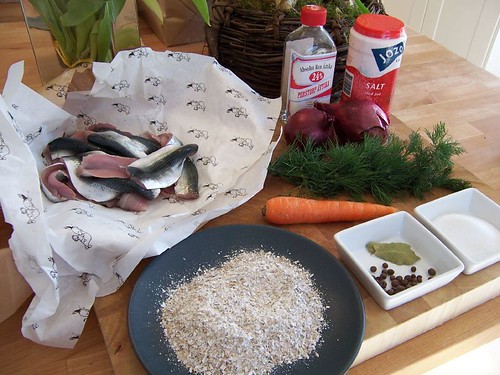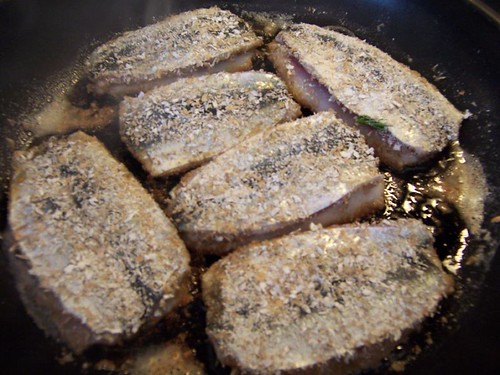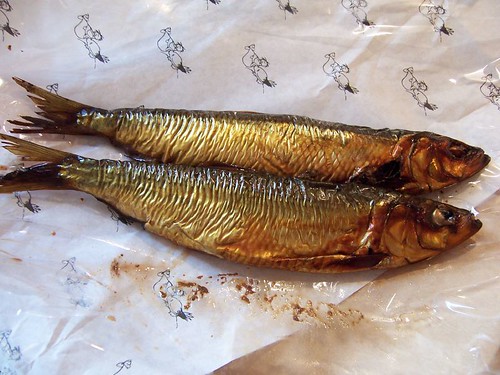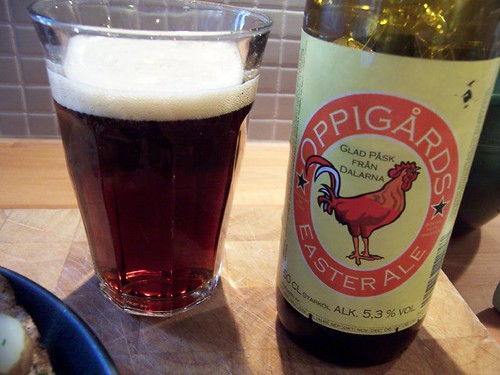More Swedish dinners: Herring x 2
More Swedish dinners: Herring x 2
-
-
-
-
-
More Swedish dinners: Herring x 2
-
Post #1 - March 30th, 2007, 6:40 amWell, I'm coming into the home stretch of my week of Swedish dinners and I thought I'd take things a little easy.
Herring, as anyone who has seen some of my earlier posts, is a central food in Sweden, Scandinavia and even Northern Europe. I've previously posted on normal "fried herring" and thought I'd now show a variation on this, "Ättikströmming".
I'll try to keep things simple today - a simple post for simple food!

Ingredients for pickled, fried herring: 1 lb. fresh herring fillets, stone-ground coarse rye flour, 1/4 cup destilled vinager, red onions, dill, carrots, a few bay leaves, 1 tblsp allspice berries, sugar (about 3 tbls) and salt.
Lay the fillets out, flesh-side up, and sprinkle with salt. Place one fillet on top of another with a little dill between.

Dredge the fillets in the rye flour and lightly fry in butter.

Arrange the fish on the bottow of a shallow dish and sprinkle with dill, the sliced red onion and the sliced carrot.

While frying the fish, pour the vinager together with about one cup of water, the sugar, a 1 1/2 tsp salt, the bay leaves and allspice into a pot and heat until the sugar/salt dissolves. Pour the slightly cooled marinade on the still-warm fish:

Cover and refridgerate for as little as a few hours but preferrably all day or overnight.
I found another type of herring at the fish store and though it would compliment the pickled I planned on making. It is called "böckling" - a slightly more mature herring that has been salted and smoked with pine or juniper.

These I simply removed the skin and bones from.
With these two herring preparations, I made two hardbread sandwiches:

On the left, buttered hardbread topped with chopped onion, dill and pickled, fried herring along with some of the pickled onions and carrots.

On the right, buttered hardbread topped with boiled potato, smoked herring, chopped onion, hardboiled egg, sour cream and dill.

Served with:

Oppigård Easter Ale - Sitting, according to my tastebuds, somewhere right inbetween a light ale or a dark lager. According to the brewers, it's hopped with American Cascade and Centennial hops and brewed with a mixture of normal and dark caramel malts. Very dry and not as heavy as it looks. It struck me as having strange notes of celery seed but perhaps I had an off-bottle. Easily the best, though, that I've had of 2007's Easter beers as the others have largely tasted yeasty and unpleasant.Last edited by Bridgestone on March 30th, 2007, 8:03 am, edited 1 time in total.
-
-
Post #2 - March 30th, 2007, 7:19 amNow that's a dinner that warms my heart. Really beautiful.
I'm not familiar with the practice of pan-frying breaded fish prior to pickling. Is this common?
Best,
Michael
-
-
Post #3 - March 30th, 2007, 7:23 amHI,
The cooked and pickled herring dish, perhaps without dill, carrots or rye flour, is something I saw an office worker eat in Zagreb, (then) Yugoslavia in the late 1980's. She knew I liked food, yes it was obvious back then, and shared a bit of her lunch with me. Her explanation of how she prepared the dish closely parallels yours.
It's funny what stuff floats to the top of your memory, that particular occasion I recall on a regular basis. My only regret was not having had more. I ate a generous sample and begged off eating more. It it was her lunch, which I am sure was never intended to be shared.
Thanks for refreshing my memory with the precise how-to, I'm going to try this in the near future.
***
I was in Amsterdam for a wedding in the mid-1980's. The bride grew up in Highwood, IL was marrying a Dutchman, who is also a foodie. We went to The Hague through an area where street vendors were selling whole pickled fish whose name declared in Dutch simply escaped me. The groom told me the real afficionados eat it whole and in one swoop. Of course, I had to eat it whole in one swoop astonishing the groom.
Is there in Sweden the same traditions of eaching fish as casual street food?
Regards,Cathy2
"You'll be remembered long after you're dead if you make good gravy, mashed potatoes and biscuits." -- Nathalie Dupree
Facebook, Twitter, Greater Midwest Foodways,
-
-
Post #4 - March 30th, 2007, 7:35 ameatchicago wrote:Now that's a dinner that warms my heart. Really beautiful.
Beautiful indeed...................
-
-
Post #5 - March 30th, 2007, 8:01 amThanks everyone for the kind words!
eatchicago - Yeah, I'd say that this method of preparing and pickling herring could be called common. Nearly every supermarket here with a real fish department has ready-made versions for sale and I'm pretty sure you can even find factory-made versions in the herring section (that is present in EVERY supermarket in Sweden). Obviously, the cooked and pickled herring have a different texture than raw pickled herring and the two compliment one another nicely.
Cathy2 - I'm always equally surprised and pleased to see that so many of these Swedish dishes awaken memories from your extensive European experiences!
I'll go out on a limb and say that the Dutch are 1) definately the crowned champs of on-the-fly herring consumption and, 2) probably the crowned champs of herring eating period. While one cannot really find raw herring available as street-food in Sweden, if you keep your eyes open (in Stockholm, at least), you may see one of the few-remaining panfried herring salesmen/stands. They are fried much like I've shown (with the rye flour) on a large griddle and served with fresh mashed potatoes. I'll see if I can document one of these stands someday...
-
-
Post #6 - March 30th, 2007, 8:03 amVery nice, but I'm intrigued by the practice of pine smoking fish. Could you elaborate on that a bit? I always thought conifers off limits to the smoking process.Steve Z.
“Only the pure in heart can make a good soup.”
― Ludwig van Beethoven
-
-
Post #7 - March 30th, 2007, 8:11 amstevez - Yeah, I've wondered a lot about this myself. I do a fair amount of American-style barbaqueing myself and absolutely every book and source I've seen says distinctly NOT to use conifer wood.
But, the Swedes (and probably Finns and Norweigens, too) do. Not always, but commonly.
Most common is definately the use of juniper. Juniper-smoked reindeer sausage is, for example, wonderful. And I've never seen any recommendations (from the normally very careful and restrictive Swedish authorities) to take it easy with the stuff. I've also seen all type of juniper-smoked fish.
Smoking with pine is certainly less common but that's the trademark of "böckling". Once again, I've never read any health concerns (over here) with this practice. But, on the other hand, most Swedes don't eat any large amounts of either böckling or juniper-smoked meat.
Interesting question, though...
-
-
Post #8 - March 30th, 2007, 8:23 amCathy2 wrote:I was in Amsterdam for a wedding in the mid-1980's. The bride grew up in Highwood, IL was marrying a Dutchman, who is also a foodie. We went to The Hague through an area where street vendors were selling whole pickled fish whose name declared in Dutch simply escaped me. The groom told me the real afficionados eat it whole and in one swoop. Of course, I had to eat it whole in one swoop astonishing the groom.
In Dutch, (nieuwe) haringen '(new) hering', eaten raw, are an especially popular treat and most likely what you have in mind... also maatjes([haringen) (German: Matjesheringe) is another term used which you might have heard.
AntoniusAlle Nerven exzitiert von dem gewürzten Wein -- Anwandlung von Todesahndungen -- Doppeltgänger --
- aus dem Tagebuch E.T.A. Hoffmanns, 6. Januar 1804.
________
Na sir is na seachain an cath.
-
-
Post #9 - March 30th, 2007, 8:46 amCathy2 wrote:I was in Amsterdam for a wedding in the mid-1980's. The bride grew up in Highwood, IL was marrying a Dutchman, who is also a foodie. We went to The Hague through an area where street vendors were selling whole pickled fish whose name declared in Dutch simply escaped me.
Rollmops?"Don't you ever underestimate the power of a female." Bootsy Collins
-
-
Post #10 - March 30th, 2007, 8:57 amDavid Hammond wrote:Cathy2 wrote:I was in Amsterdam for a wedding in the mid-1980's. The bride grew up in Highwood, IL was marrying a Dutchman, who is also a foodie. We went to The Hague through an area where street vendors were selling whole pickled fish whose name declared in Dutch simply escaped me.
Rollmops?
Rolmops (one 'l') are just the filets, pickled and rolled around a pickle. C2 said they were pickled, which Hollandse nieuwe haringen aren't but the street consumption of whole fish in Den Haag sounds to me as though it likely involved nieuwe or maatjes- haringen.
kijk eens:
http://www.bnr.nl/blobs/anp/28838.jpg
AntoniusAlle Nerven exzitiert von dem gewürzten Wein -- Anwandlung von Todesahndungen -- Doppeltgänger --
- aus dem Tagebuch E.T.A. Hoffmanns, 6. Januar 1804.
________
Na sir is na seachain an cath.
-
-
Post #11 - March 30th, 2007, 9:07 amHi,
Antonius, Thanks for the vocabulary, though I cannot even begin to recall the words because they were so unfamiliar. I am going to link this post to my friends for the comments and amusement.
Hammond: rollmops? No. These fish were intact except for being gutted and possibly deheaded. I think they were 5-6 inches long, maybe even more.
Regards,Cathy2
"You'll be remembered long after you're dead if you make good gravy, mashed potatoes and biscuits." -- Nathalie Dupree
Facebook, Twitter, Greater Midwest Foodways,
-
-
Post #12 - March 30th, 2007, 9:49 amEscabeche/escovitch recipes are very similar in technique, and found around the Mediterranean, Caribbean and South America. Sometimes the fish is dredged in flour, sometimes not.
Let me add my thanks to Bridgestone for a series of impressive documents. The dry-aged steak photos made me cry.
-
-
Post #13 - April 1st, 2007, 11:05 amHI,
As I promised, I sent a link to my friend Karin's husband Rolf who responded with information on the Dutch herring:
A typical Dutch delicacy is raw herring (Hollandse Nieuwe - pronounced: Haullandse Niuvuh / Dutch New Herring). This is typically eaten with raw onions. Hollandse Nieuwe is only available in spring when the first seasonal catch of herring is brought in. This is celebrated in festivals such as Flag Day (Vlaggetjes Dag – pronounced: Fluggetches Dahg) in Schevingen near The Hague. The new herring are frozen and enzyme-preserved for the remainder of the year.
The raw herring is not pickled but preserved by fermentation. (Dutch word: haring kaken / pronounced: hahring kahken) A procedure invented by Willem Beukelszoon in 1380. Kaken involves using a special knife to remove the head, gills and all of the innards except for the pancreas of the immature herring. In spring the pancreas is enlarged and contains an enzyme that helps the living animal to convert its food into fat. These enzymes are essential in the fermentation process, which in turn influences the flavour of the herring. This process is influenced by salting the herring: the more salt, the longer it keeps and therefore the longer it ferments. Before refrigeration was available salting was the only means of preserving the fish. Nowadays, however, it is possible to preserve the herring without salt, but some people still prefer the old-fashioned salted and fermented herring. To mask the salty and oily flavour the herring was and is often eaten with finely chopped onion.
Different regions of the Netherlands have different preferences in taste. This is due to historical factors. Before refrigeration was available it was necessary to use more salt to preserve fish meant for areas far from the coast. To this day south-eastern parts of the country still prefer the saltier variety, whereas the coastal regions prefer their fish less salty.
There are more peculiar preferences in herring consumption. Amsterdam likes its herring cut up in segments of about an inch but Rotterdam likes smaller herrings in one piece.Cathy2
"You'll be remembered long after you're dead if you make good gravy, mashed potatoes and biscuits." -- Nathalie Dupree
Facebook, Twitter, Greater Midwest Foodways,

